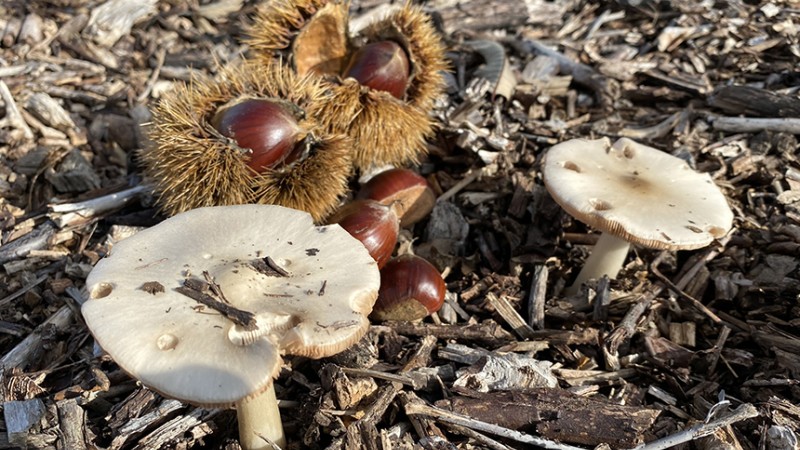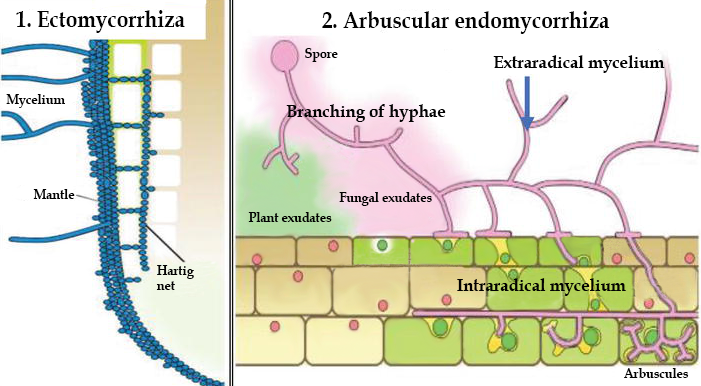
Ectomycorrhiza and endomycorrhiza are two different types of symbiotic relationships formed between fungi and plant roots.
The main difference between them lies in the way the fungal hyphae (fungal fibers) permeate the root cells of the host plant.
In arbuscular mycorrhiza, the fungus penetrates the root bark intercellularly and intracellularly; we call this symbiotic relationship endomycorrhiza.
In ectomycorrhiza, however, the fungus only penetrates the root bark intercellularly and does not form arbuscules or vesicles as in arbuscular mycorrhiza.

1. Ectomycorrhiza:
- In ectomycorrhiza, the fungal hyphae surround the outer cell layers of the root without penetrating the root cells.
- The fungal hyphae form a sheath around the root tips and extend into the surrounding soil, forming a dense network called the mantle.
- The fungal hyphae also penetrate the intercellular spaces within the cortex of the root, forming structures called Hartig nets.
- Ectomycorrhiza is primarily formed by fungi belonging to the phyla Basidiomycota and Ascomycota.
- This type of mycorrhiza is commonly found on trees such as conifers and deciduous trees such as chestnut, oak, beech and hornbeam and is associated with the formation of above-ground fungal fruiting bodies.
2. Endomycorrhiza (Arbuscular Mycorrhiza):
- In endomycorrhiza, the fungal hyphae penetrate the root cells and establish a close association with the plant cells.
- The fungal hyphae penetrate the root cells through specialized structures called arbuscules, which form inside the cells.
- The presence of arbuscules allows for the exchange of nutrients and other beneficial molecules between the fungus and the plant.
- Endomycorrhiza is primarily formed by fungi belonging to the phylum Glomeromycota.
- This type of mycorrhiza is found in a wide range of plant species, including most agricultural crops, grasses, and some trees.
In summary, ectomycorrhiza forms a sheath around the root without penetrating the cells, whereas endomycorrhiza forms a symbiotic association by penetrating the root cells through specialized structures.
Arbuscular mycorrhizal fungi create two types of mycelium, each of which is aimed at fulfilling specific functions.
The mycelium that grows from the roots into the surrounding soil is called extraradical mycelium. In the soil zone around the roots, it creates a network of extraradical mycelial structure, which increases the absorption surface of the fungus and facilitates the translocation of mineral nutrients from the soil to the host plants. Extraradical hyphae obtain phosphorus from inaccessible forms, provide it to plants and initiate colonization by other types of soil microflora. This mycelium is responsible for finding nutrients and water in the soil and also plays a role in the decomposition of organic matter.
The mycelium that forms in the root of the plant is called intraradical mycelium, it differs morphologically and functionally from extraradical mycelium and forms two unique structures:
- a highly branched structure formed inside the root cells, the so-called arbuscules, which are considered a key element of symbiotic nutrient exchange
- a balloon-like structure called a vesicle for storing nutrients, which is located in the cells of the root bark of the host plant
In summary, the main difference between intraradical and extraradical arbuscular mycelium lies in their location and their specific functions in the symbiotic relationship between fungi and plants in arbuscular mycorrhizal associations.






